
Display Contents
Introduction
North side
South side
The word misericord comes
from the Latin "misericordia" meaning mercy. It describes carved
brackets on the undersides of seats which were used by monks during
church services. The idea was that the monks could lean against the
misericord and so experience relief from the strain of standing for
long periods.
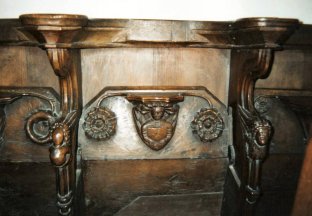
Minster church has eighteen misericords,
one of the largest collections
in Kent. They date from around 1420 and include images of daily life,
local legends and Bible stories. Each misericord has a central figure
with two smaller supporting images either side.
North side
From the altar to the pulpit.
1.
A person sits spinning with a cat on
the left and dog on the right.
On one side of the figure is a fox which has a bird in its mouth, a
creature it has clearly stolen. To the right is a man's face.
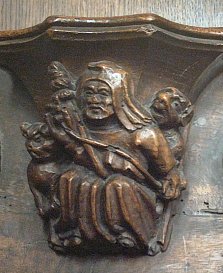
2.
A plain stall with two quatrefoil
flowers flanking. Whether the
stall was not finished or was damaged over the years and replaced with
a plain replica is uncertain.
3. An angel with a blank shield flanked by two roses. The rose was a traditional heraldic and decorative image but was also the symbol of the Lancastrians. Henry V who led the army at Agincourt was a Lancastrian with much local support. The angel's hair is shown splayed like a halo.
4. Two eagles back to back flanked by dolphins. The eagle is a traditional symbol of the Gospel representing strength. The dolphins are curved into a circle to represent eternity. Traditionally, dolphins were regarded as loving music and choral music was one of the glories of the church.
3. An angel with a blank shield flanked by two roses. The rose was a traditional heraldic and decorative image but was also the symbol of the Lancastrians. Henry V who led the army at Agincourt was a Lancastrian with much local support. The angel's hair is shown splayed like a halo.
4. Two eagles back to back flanked by dolphins. The eagle is a traditional symbol of the Gospel representing strength. The dolphins are curved into a circle to represent eternity. Traditionally, dolphins were regarded as loving music and choral music was one of the glories of the church.
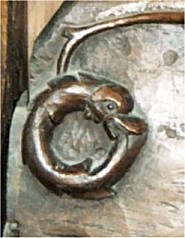
5.
A woman with a very high horned
head-dress through which is peeping
a demon. The figure is flanked by two demons, that to the left with the
eyes open, that on the right with the eyes shut. Both have their
tongues out showing their disrespect. The carving illustrates the view
of vanity as a deadly sin.
6. The arms of the St Nicholas family upon which have been impaled the arms of Debnam. They are almost certainly the arms of John St Nicholas. Directly behind the stall is the chapel where the St Nicholas family were buried. The arms are flanked by two angels with blank shields.
7. The arms of one of the Manston family, probably William's brother - see No. 9. The central crescent denotes a second son. William had three sons but they would have been children when the misericords were carved. The flanking shields are blank. His brother had no surviving children which may explain the empty shields.
8. The deer which Domneva is said to have released at Westgate and whose run determined the boundaries of Minster Abbey lands, later held by St Augustine's. The animal is flanked by stylised leaves.
6. The arms of the St Nicholas family upon which have been impaled the arms of Debnam. They are almost certainly the arms of John St Nicholas. Directly behind the stall is the chapel where the St Nicholas family were buried. The arms are flanked by two angels with blank shields.
7. The arms of one of the Manston family, probably William's brother - see No. 9. The central crescent denotes a second son. William had three sons but they would have been children when the misericords were carved. The flanking shields are blank. His brother had no surviving children which may explain the empty shields.
8. The deer which Domneva is said to have released at Westgate and whose run determined the boundaries of Minster Abbey lands, later held by St Augustine's. The animal is flanked by stylised leaves.
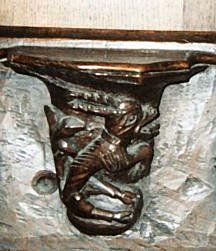
9.
The coat of arms of William Manston
flanked by fleur-de-lis. Manston
was at the Battle of Agincourt in 1415. He served with distinction and
later became Sheriff of Kent. He lived from around 1375 to 1440.
10. Three ladies wearing the horned head-dresses of the 1420s as popularised by Katherine de Valois who married Henry V in 1420. The flanking figures have a female head on a serpents body. The association of evil with woman and the serpent dates back to Eve in the Garden of Eden. The central figure has a winged, scaly body and talons like a dragon.
10. Three ladies wearing the horned head-dresses of the 1420s as popularised by Katherine de Valois who married Henry V in 1420. The flanking figures have a female head on a serpents body. The association of evil with woman and the serpent dates back to Eve in the Garden of Eden. The central figure has a winged, scaly body and talons like a dragon.
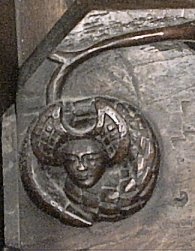
1.
The face of Christ is central on this
stall. The faces either side
probably represent the malefactors who were crucified with Christ
although it is more common in images of the time to see their faces
turned to Him to show their repentance. They could be cartoons of
monks, the artist suggesting they lacked godly lifestyles and had
turned their back on truth.
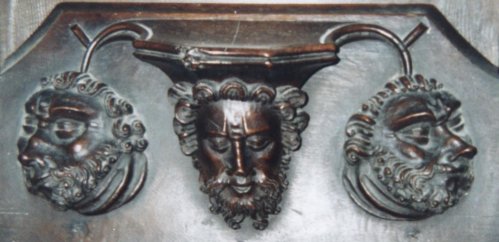
2. The
central figure is bearing a
banner with the initials "IHC" which
represents the Greek name of Jesus. The flanking figures are wyverns, a
form of dragon with wings and a serpents tail. The wyvern is most often
associated with Wales today but was a common medieval image.
3. The central head has vegetation spewing from the mouth and around the entire face. It is what is often called a "green man." A similar head exists at St Nicholas. It represents rebirth and fertility. The birds either side with their banners represent those sent from the ark by Noah in search of dry land.
4. A cartoon of a cook with his mouth open to yell orders as he stirs the contents of a large pot. He is flanked by two birds who are clearly destined to be part of the meal.
3. The central head has vegetation spewing from the mouth and around the entire face. It is what is often called a "green man." A similar head exists at St Nicholas. It represents rebirth and fertility. The birds either side with their banners represent those sent from the ark by Noah in search of dry land.
4. A cartoon of a cook with his mouth open to yell orders as he stirs the contents of a large pot. He is flanked by two birds who are clearly destined to be part of the meal.
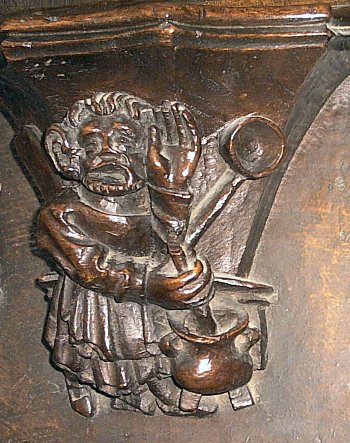
5.
The flanking figures bear labels
Johannes Curteis. John Curtis was
vicar of the church from 1401 to 1419. The stalls were started late in
his ministry but clearly took at least a decade to complete. Vicars
were not allowed to have beards so it is probably not an image of
Curtis and it is unlikely he led worship from this seat. The badge on
the cap suggests it could be a pilgrim.
6. A preacher, possibly a friar, flanked by the heads of two heathens. It was probably meant to represent St Augustine who landed in England in the parish of Minster in 597 and preached to the pagan Anglo-Saxons.
6. A preacher, possibly a friar, flanked by the heads of two heathens. It was probably meant to represent St Augustine who landed in England in the parish of Minster in 597 and preached to the pagan Anglo-Saxons.
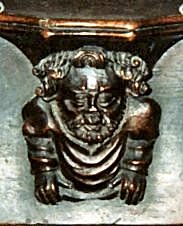
7.
The central image could represent
Christ or St George. There was a
gilded image of St George at Minster during the middle ages. Dragons
appear either side representing the evil which is ever present but
ultimately overcome.
8. An angel playing a stringed instrument to remind people that heaven rang with angelic choirs and musicians. The flanking figures show how all manner of creation exists under heaven.
8. An angel playing a stringed instrument to remind people that heaven rang with angelic choirs and musicians. The flanking figures show how all manner of creation exists under heaven.
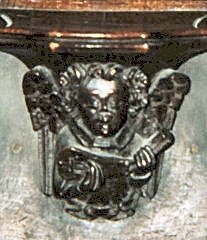
Version 1 - Posted 13.05.07
All content © Trust for Thanet Archaeology